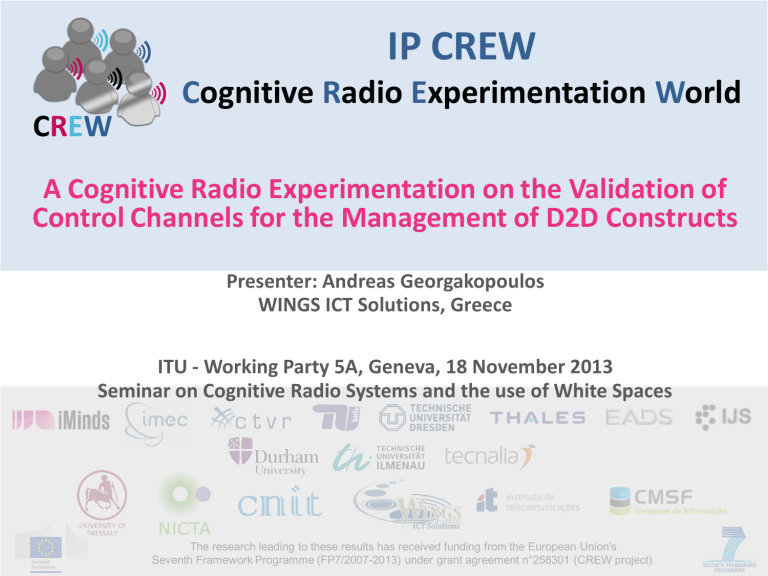IP CREW C R E

C R E W
IP CREW
C ognitive R adio E xperimentation W orld
C R E W
A Cognitive Radio Experimentation on the Validation of
Control Channels for the Management of D2D Constructs
Presenter: Andreas Georgakopoulos
WINGS ICT Solutions, Greece
ITU - Working Party 5A, Geneva, 18 November 2013
Seminar on Cognitive Radio Systems and the use of White Spaces
The research leading to these results has received funding from the European Union's
Seventh Framework Programme (FP7/2007-2013) under grant agreement n
°
258301 (CREW project).
Outline
C R E W
■ IP CREW Overview
●
●
●
●
IP CREW Identity
IP CREW Target
IP CREW Platform
The CREW offer
■ Cognitive Control Channels Experimentation
● Motivation
●
●
●
●
●
●
●
●
Rationale
Related topics
Data structures
Scenario
Architecture
Functionality
Experimentation environment
Indicative results
1
C R E W
IP CREW Overview
2
IP CREW: Identity
C R E W
■ Cognitive Radio Experimentation World
●
●
●
●
FP7 call 5 (FIRE - Future Internet Research and Experimentation Initiative )
Project started October 2010
8 core partners
3+6 open call partners
– UDUR (UK)
– TUIL (DE)
OC1
– TECNALIA (ES)
– IT (PT)
– CMSF (PT)
– CNIT (IT)
– WINGS (GR)
– UTH (GR)
– NICTA (AU)
OC2
3
IP CREW: Target
C R E W
■ establish an open federated test platform , facilitating experimentally-driven research on
●
●
●
● advanced spectrum sensing cognitive radio (CR) cognitive networking (CN) spectrum sharing in licensed and unlicensed bands
SDR
DVB
4
C R E W heterogeneous ISM
@ Ghent (iMinds)
IP CREW: Platform
WinnF Transceiver Facility (API) wireless sensor
@ Berlin (TUB)
IMEC sensing agent
TV-bands
@ Dublin (TCD) ISM/TVWS outdoor
@ Ljubljana (JSI)
IRIS SW radio
LTE-advanced
@ Dresden (TUD)
IEEE 802.11
IEEE 802.15.1
IEEE 802.15.4
LTE-advanced
EyesIFX nodes
CR database
IRIS GPP-based so ware radio pla orm
Comreg spectrum licenses
BEE2 FPGA pla orm
USRP so ware radio
VESNA pla orm on light pole
TCS multi-antenna LTE detection
TV
ISM
IMEC Sensing Agent
UHF/VHF TV sensing
ISM bands sensing
TCS Mul -antenna LTE detec on
WiSpy Spectrum analyzer
Interconnec on of portals
Interconn. between testbed elements 5
The CREW offer
C R E W
■ Open access to 5 different testbed islands and advanced cognitive components
Ghent Berlin
● different wireless technologies
●
●
● different spectrum bands mature testbeds
Internet methodologies and tools for
CREW portal experimentation
● reproducible test conditions
● expertise from PHY layer
to application layer
Dublin
Dresden
ISM TV
Ljubljana
■ Portal with detailed information and guidelines on access and use of the facilities (www.crew-project.eu)
■ Technical support & assistance to experimenters
● methodologies for experimentation
6
C R E W
Cognitive Control Channels
Experimentation
7
Some background
C R E W
■ Work was stimulated by research conducted in the context of the Wireless World Research Forum
(WWRF)
■ WWRF is the unique forum where the wireless community can tackle the key research challenges
■ Elaboration on key aspects was conducted through our SME (WINGS ICT Solutions)
■ Experiments are executed through the participation of WINGS in the CREW project, which provides the necessary experimentation facilities
8
WINGS-ICT-Solutions profile
C R E W
■ WINGS focuses on conducting R&D and providing consulting services in all areas related to telecommunication networks and services
■ Wide expertise on:
■ Comprises a team of selected, experienced engineers and computer scientists
9
Experimentation: Motivation
C R E W
■ Mechanisms for management of wireless infrastructure
■ Mechanisms for realizing infrastructure offloading scenarios
■ Mechanisms for managing
D2D networking solutions
10
Experimentation: Rationale
C R E W
■ Control Channels for Cognitive Radio Systems (CC-CRSs) have been identified as a key feature required for supporting CRSs in their operation, through conveying information and knowledge on the:
●
●
● context of operation (traffic/mobility/interference conditions) the involved profiles (of users/applications/devices) and the valid policies (e.g., objectives to be pursued and constraints to be respected, designated by stakeholders, i.e., operators, regulators)
■ The aim of this work is to perform experiment-based validation of control channels for Cognitive Radio Systems
11
C R E W
Experimentation: Related topics to cognitive control channels
■ Related ETSI Technical Reports
●
●
ETSI TR 102 682 V1.1.1, "Reconfigurable Radio Systems (RRS); Functional Architecture (FA) for the
Management and Control of Reconfigurable Radio Systems", 2009
ETSI TR 102.683, v1.1.1, “Reconfigurable Radio Systems (RRS); Cognitive Pilot Channel (CPC)”, 2009
● ETSI TR 102 684 V1.1.1, "Reconfigurable Radio Systems (RRS); Feasibility Study on Control Channels for
Cognitive Radio Systems", 2012
■ Related publications
● S.Buljore, H.Harada, P.Houze, K.Tsagkaris, O.Holland, S.Filin, T.Farnham, K.Nolte, V.Ivanov, “Architecture and enablers for optimized radio resource usage in heterogeneous wireless access networks: The IEEE 1900.4
Working Group”, IEEE Commun. Mag., Vol. 47, no. 1, pp. 122-129, Jan. 2009
●
●
M.Mueck, A.Piipponen, G.Dimitrakopoulos, K.Tsagkaris et al., “ETSI Reconfigurable Radio Systems – Status and Future Directions on Software Defined Radio and Cognitive Radio Standards”, Communications
Magazine, IEEE, vol.48, no.9, pp.78-86, Sep. 2010
V. Stavroulaki, K. Tsagkaris, P. Demestichas, J. Gebert, M. Mueck, A. Schmidt, R. Ferrus, O. Sallent, M. Filo, C.
Mouton, L. Rakotoharison, "Cognitive control channels: from concept to identification of implementation options," Communications Magazine, IEEE , vol.50, no.7, pp.96-108, Jul. 2012
● D. Karvounas, A. Georgakopoulos, V. Stavroulaki, K. Tsagkaris, P. Demestichas, "Evaluation of Signaling Load in Control Channels for the Cognitive Management of Opportunistic Networks", to appear to European
Transactions on Telecommunications, Wiley, 2013
■ Related projects
●
●
FP7/ICT project OneFIT (Opportunistic networks and Cognitive Management Systems for Efficient
Application Provision in the Future InterneT), http://www.ict-onefit.eu
FP7/ICT project E3 (End-to-End Efficiency), https://ict-e3.eu/
12
Experimentation: Data structures
C R E W
■ Specific data structures have been defined related to:
● Profiles
●
●
●
●
Context
Policies
Decisions
Knowledge
13
Experimentation: Indicative Scenario
C R E W
■ Coverage expansion of the infrastructure
■ An AP unexpectedly transits to an offline mode
■ Terminals that were served by the problematic AP shall identify neighboring terminals that are connected to alternative APs
■ Opportunistic creation of (ad-hoc) cognitive radio network and redirection of traffic to alternative APs, also through the neighboring terminals
14
C R E W
Experimentation:
Architecture and Functionality
Nodes/ Terminals
Context
Profiles
Policies
Decision
Making
Enforcement
Network Management Entity
(NME)
Registration of elements
Monitoring
Nodes/ Infrastructure APs
Context
Profiles
Decision
Making
Policies
■ Decision making functionality may take place on the terminal side or the infrastructure side, depending on the scenario utilized
15
Experimentation: Functionality
C R E W
NME
■ NME: Entity for registering network elements (e.g., infrastructure APs) and for monitoring the network Registration
& Monitoring
Terminal
Context Acquisition
Decision Making
Enforcement
AP
16
Experimentation: Environment
C R E W
■ CREW facilities in iMinds
(Ghent) utilized
Terminal iMinds w-iLab.t testbed (Ghent)
Zwijnaarde environment
Terminal
NME
SFTP and media server
Terminal
JADE platform
AP
17
C R E W
Experimentation: Indicative results
Visualization of exchanged messages
-Signaling load increasing as more hops are added to the
D2D network
-This is due to more exchanged information between more elements
18
C R E W
Experimentation: Indicative results
Gradual degredation after 2 hops
TCP application performance vs. # of hops
Ping performance vs. # of hops
Gradual increase of RTT
Significant degredation after 7 hops
UDP application performance vs. # of hops
Performance of edge vs. intermediate nodes
Significant degredation after 7 hops
■ Performance tends to degrade as more nodes are added to the D2D network
■ Degradation level differs depending on the applications used
19
Conclusions
C R E W
■ Through control channels we are able to exchange contextual information of the environment
■ By knowing the status of the environment, decision making on the creation of D2D connections can be triggered
■ Performance of solutions enforced can be evaluated in order to assess the impact of the decision
■ Quality of D2D communications is affected by the number of hops and the type of application (streaming, file transfer, ping)
■ Quality of communication tends to degrade and higher amount of signaling information is being exchanged as more hops are added to a D2D network
20
C R E W
Thank You!
21




